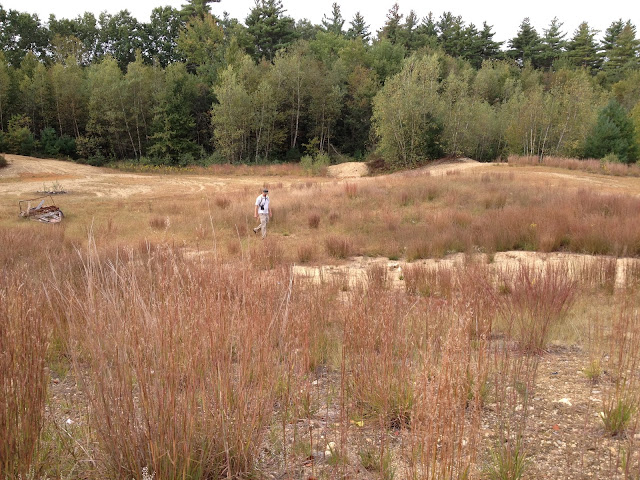On Tuesday I was out with three colleagues walking through several hundred acres of conserved land. We were there to look at wetlands and turtle nesting areas and talk about how to deal with an old gravel pit. You would think that a gravel pit would be a wildlife disaster area, and it can be if off-road vehicles don't leave it alone.
One of the stewardship issues at this site was blocking people from riding their ATVs through the sandy pit. If such areas are left alone, natural vegetation will grow back and create pockets of habitat for turtle nesting, for small mammals, for insects, and bigger creatures looking for a meal. We could already see this happening in spots as we walked through the undulating topography of the old pit.
Mike Marchand, turtle expert and wetlands wildlife biologist with NH Fish and Game, was with us. He had a keen eye for finding turtle nests in the gravel pit. He showed us nests that were predated on by skunks or raccoons or some other predator, where egg shell fragments were lying about on the surface. When a turtle nest is successful, the eggs hatch underground, and the newborn turtles crawl through the soil to the surface. Therefore, it is easier to detect failed nests because of the shell fragments. Here is one such nest; note the white shell fragments. The other holes appear to be ants or some other insect digging in the soft sand.
Another intriguing find at the edge of the pit, beneath an overhang, were ant lion pitfall traps.
The larval form of an antlion is a scary proposition if you are an ant or other small insect. The antlion larvae digs a small pit about 2 inches across and 1 inch deep. When an ant crawls to the edge of the pit, the antlion, buried in the pit with just its large pincers sticking out, starts tossing up grains of sand to start an avalanche which causes the ant to fall in. After it sucks out the ant juices, the antlion flings the remains of its prey out of the pit. Wow! Good thing this insect is small. And the adult form is a lacy-winged, weak flyer, although I read that they can also give a painful bite.
As we continued our walk about in the gravel pit we saw many dime-sized holes in the sand. Mike and I thought these might be meadow vole holes, but they could be made by short-tailed shrews as the holes were an inch or less in diameter.
Not far from those small mammal hole, we found a depression in the sand and gravel, where a beetle had just de-capitated a wasp.
We saw raccoon scat--one of the turtle nest perps--which I suppose only a wildlife biologist could find interesting enough to post on her blog.
We finally left the gravel pit behind, marveling at the diverse and interconnected (and violent) food web there. At first glance the old gravel pit seemed barren, only a closer look showed otherwise.
Subscribe to:
Post Comments (Atom)
Our Wetland in Winter
We moved to our house in 1994, 31+ years ago. Our backyard abuts a large wetland that froze enough each winter that we could walk, snowshoe,...

-
The oldest known hardwood tree in North America--at 700 years old--is a black gum tree tucked away in a hummocky swamp in southern New Hamps...
-
On Sunday I brought home a fragment of an animal skeleton from Seapoint Beach. At first it looked like a baby dragon, but that's just to...
-
Big Island, Hawaii was fantastic. We are already planning another trip in 2020. Here are a few final thoughts and tips... Join Costco ...












Thanks for providing the Gravel Pit related information. This information is very helpful for me..
ReplyDelete